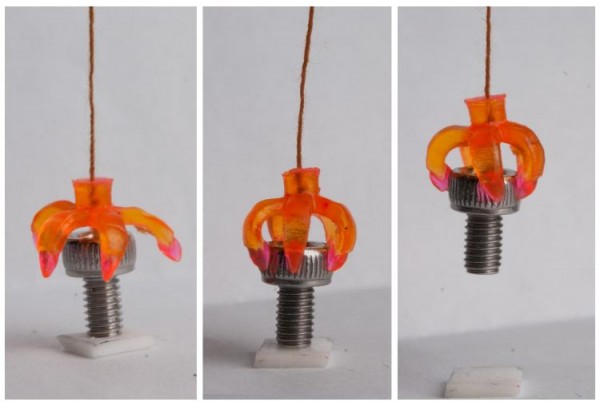Researchers from MIT and Singapore Develop Method to Print 3D Structures that 'Remember' their Shapes
| Arthur Dominic Villasanta | | Aug 29, 2016 05:17 AM EDT |
(Photo : Qi (Kevin) Ge) A 3-D printed multimaterial shape-memory minigripper, consisting of shape-memory hinges and adaptive touching tips, grasps a cap screw.
Engineers from MIT and Singapore University of Technology and Design (SUTD) have developed a method to 3D print shape-memory materials that can "remember" their shapes, opening the door to 4D printing at the micron-scale.
The research team used light to print these self-deforming 3D structures that spring back to their original shapes after being triggered by a stimulus such as body heat. They've shown the structures sprang back to their original forms within seconds of being heated to a certain temperature "sweet spot" even after being stretched, twisted and bent at extreme angles. This incredible capability was proven on small coils to an inch-tall replica of the Eiffel tower created using this method.
Like Us on Facebook
For some structures, researchers were able to print micron-scale features as small as the diameter of a human hair. These dimensions are at least one-tenth as big as what others have been able to achieve with printable shape-memory materials. The team's results were published earlier this month in the online journal Scientific Reports.
The shape-memory material can bounce back to its original printed form, within a specific temperature range -- in this case, between 40 and 180 degrees Celsius (104 to 356 degrees Fahrenheit).
The team printed a variety of structures, including coils, flowers, and the miniature Eiffel tower, whose full-size counterpart is known for its intricate steel and beam patterns. They found the structures could be stretched to three times their original length without breaking.
When they were exposed to heat within the range of 40 C to 180 C, they snapped back to their original shapes within seconds.
Nicholas X. Fang, associate professor of mechanical engineering at MIT, said shape-memory polymers that can predictably morph in response to temperature can be useful for a number of applications, from soft actuators that turn solar panels toward the sun, to tiny drug capsules that open upon early signs of infection.
"We ultimately want to use body temperature as a trigger," said Fang. "If we can design these polymers properly, we may be able to form a drug delivery device that will only release medicine at the sign of a fever."
Fang's coauthors include former MIT-SUTD research fellow Qi "Kevin" Ge, now an assistant professor at SUTD; former MIT research associate Howon Lee, now an assistant professor at Rutgers University; and others from SUTD and Georgia Institute of Technology.
Ge says the process of 3D printing shape-memory materials can also be thought of as 4D printing, as the structures are designed to change over the fourth dimension of time.
"Our method not only enables 4D printing at the micron-scale, but also suggests recipes to print shape-memory polymers that can be stretched 10 times larger than those printed by commercial 3D printers," said Ge.
"This will advance 4D printing into a wide variety of practical applications, including biomedical devices, deployable aerospace structures and shape-changing photovoltaic solar cells."
Fang and others have been exploring the use of soft, active materials as reliable, pliable tools. These new and emerging materials, which include shape-memory polymers, can stretch and deform dramatically in response to environmental stimuli such as heat, light, and electricity.
These are properties researchers have been investigating for use in biomedical devices, soft robotics, wearable sensors, and artificial muscles.
"The reality is that, if you're able to make it to much smaller dimensions, these materials can actually respond very quickly, within seconds," said Fang. "For example, a flower can release pollen in milliseconds. It can only do that because its actuation mechanisms are at the micron scale."
To print shape-memory structures with even finer details, Fang and his colleagues used a 3D printing process they have pioneered, called microstereolithography in which they use light from a projector to print patterns on successive layers of resin.
"We're printing with light, layer by layer," said Fang. "It's almost like how dentists form replicas of teeth and fill cavities, except that we're doing it with high-resolution lenses that come from the semiconductor industry, which give us intricate parts, with dimensions comparable to the diameter of a human hair."
TagsMIT, Singapore University of Technology and Design, shape-memory materials, 4D printing, Nicholas X. Fang
©2015 Chinatopix All rights reserved. Do not reproduce without permission
EDITOR'S PICKS
-

Did the Trump administration just announce plans for a trade war with ‘hostile’ China and Russia?
-

US Senate passes Taiwan travel bill slammed by China
-

As Yan Sihong’s family grieves, here are other Chinese students who went missing abroad. Some have never been found
-

Beijing blasts Western critics who ‘smear China’ with the term sharp power
-

China Envoy Seeks to Defuse Tensions With U.S. as a Trade War Brews
-

Singapore's Deputy PM Provides Bitcoin Vote of Confidence Amid China's Blanket Bans
-

China warns investors over risks in overseas virtual currency trading
-

Chinese government most trustworthy: survey
-

Kashima Antlers On Course For Back-To-Back Titles
MOST POPULAR
LATEST NEWS
Zhou Yongkang: China's Former Security Chief Sentenced to Life in Prison

China's former Chief of the Ministry of Public Security, Zhou Yongkang, has been given a life sentence after he was found guilty of abusing his office, bribery and deliberately ... Full Article
TRENDING STORY

China Pork Prices Expected to Stabilize As The Supplies Recover

Elephone P9000 Smartphone is now on Sale on Amazon India

There's a Big Chance Cliffhangers Won't Still Be Resolved When Grey's Anatomy Season 13 Returns

Supreme Court Ruled on Samsung vs Apple Dispute for Patent Infringement

Microsoft Surface Pro 5 Rumors and Release Date: What is the Latest?














